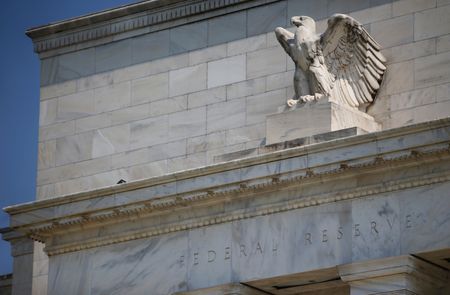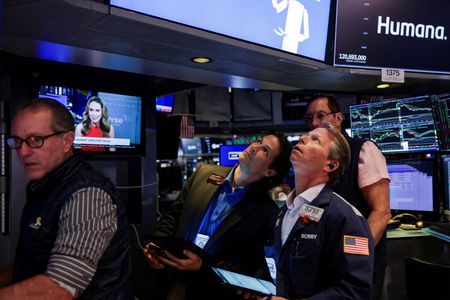By Alun John and Naomi Rovnick
LONDON (Reuters) -The pace of global rate cuts is slowing as the European Central Bank nears the end of its easing cycle, the U.S. Federal Reserve stays cautious about tariff-driven inflation and investors watch to see whether Britain speeds up from here.
The Fed struck a hawkish tone on Wednesday alongside holding rates steady, an approach that lifted the dollar and assuaged fears that President Donald Trump’s intense pressure on chair Jerome Powell has eroded central bank independence.
Here’s where 10 big central banks stand:
1/ SWITZERLAND
Bets that the Swiss National Bank will use negative interest rates to tackle the seemingly unstoppable rise of the safe haven franc have faded after it kept benchmark borrowing costs on hold at 0% in June.
Traders regard another pause in September as near certain and speculate that the SNB has started intervening to weaken the franc.
2/ CANADA
The Bank of Canada held its key policy rate at 2.75% for the third straight meeting on Wednesday, citing lower risks of a severe and escalating global trade war.
But it declined to give detailed economic forecasts, citing uncertainty around U.S. trade policy, and said that if the economy weakened further it could cut rates again.
The BoC has eased rates by 225 basis points since June 2024, and markets see a reasonable chance of one more cut by year end.
3/ SWEDEN
Ahead of Sweden’s disappointing second quarter GDP data on Tuesday, the Riksbank cut its key rate to 2% last month and said policy could be eased again this year if inflation remains tame and growth remains weak.
4/ NEW ZEALAND
The Reserve Bank of New Zealand, which has cut rates by 225 bps already this cycle, held borrowing costs steady earlier this month but said it expected to loosen monetary policy if price pressures continued to ease as expected.
5/ EURO ZONE
The European Central Bank held steady last week after cutting eight times in a year, and many analysts expect it is finished with easing this cycle.
The EU-U.S. trade deal took worst-case tariff scenarios off the table, and, alongside the ECB’s relatively upbeat assessment of the economic outlook, allayed fears that inflation would fall significantly below its 2% target.
The ECB’s main policy rate is currently at 2%, down from 4% a year ago, though markets see some chance of one more cut.
6/ UNITED STATES
The Federal Reserve stayed on pause on Wednesday and traders responded to Chair Jerome Powell’s comments by cutting bets that borrowing costs would begin to fall in September, putting $18 billion worth of bets on dollar weakness in danger.
That could stoke the ire of President Donald Trump who has demanded immediate and steep rate relief.
Powell said the Fed is focused on controlling inflation – not on government borrowing or home mortgage costs that Trump wants lowered.
He added that the risk of rising price pressures from the administration’s trade and other policies remains too high for the Fed to begin loosening its “modestly restrictive” grip on the economy until more information is collected.
The Fed has been on hold all this year, and markets see less than a 50% chance of a rate cut in September.
7/ BRITAIN
The Bank of England meets on Aug 7.
Markets expect a 25-bps rate cut even after data this month showed a surprise jump in inflation and a less-dramatic-than-feared cooling in the labour market.
Sticky inflation means the BoE has been more cautious than most with easing. Markets price two, 25-bp rate cuts by year-end – including an August move.
8/ AUSTRALIA
The Reserve Bank of Australia is cautious too and surprised markets earlier this month by holding rates steady at 3.85%, as it awaited confirmation that inflation is continuing to slow.
Wednesday data showing Australian consumer prices grew at the slowest pace in over four years in the June quarter should help, and markets are near certain the RBA will cut its 3.85% cash rate by 25 bps next month, and continue easing to 3.10% by year end.
9/ NORWAY
Norway’s central bank cut rates by 25 bps to 4.25% last month, its first reduction since 2020 but with only one more fully priced for 2025.
The Norges Bank has been the most cautious among developed market central banks, and data this month showing core inflation at 3.1% reinforced this stance.
10/ JAPAN
The Bank of Japan, the sole major central bank in hiking mode, kept interest rates steady at 0.5% on Thursday, but revised up its inflation forecasts and offered a less gloomy outlook on the economy than three months ago.
Those changes maintained confidence about the BOJ resuming hikes this year.
(Reporting by Alun John and Naomi Rovnick; editing by Mark Heinrich)










